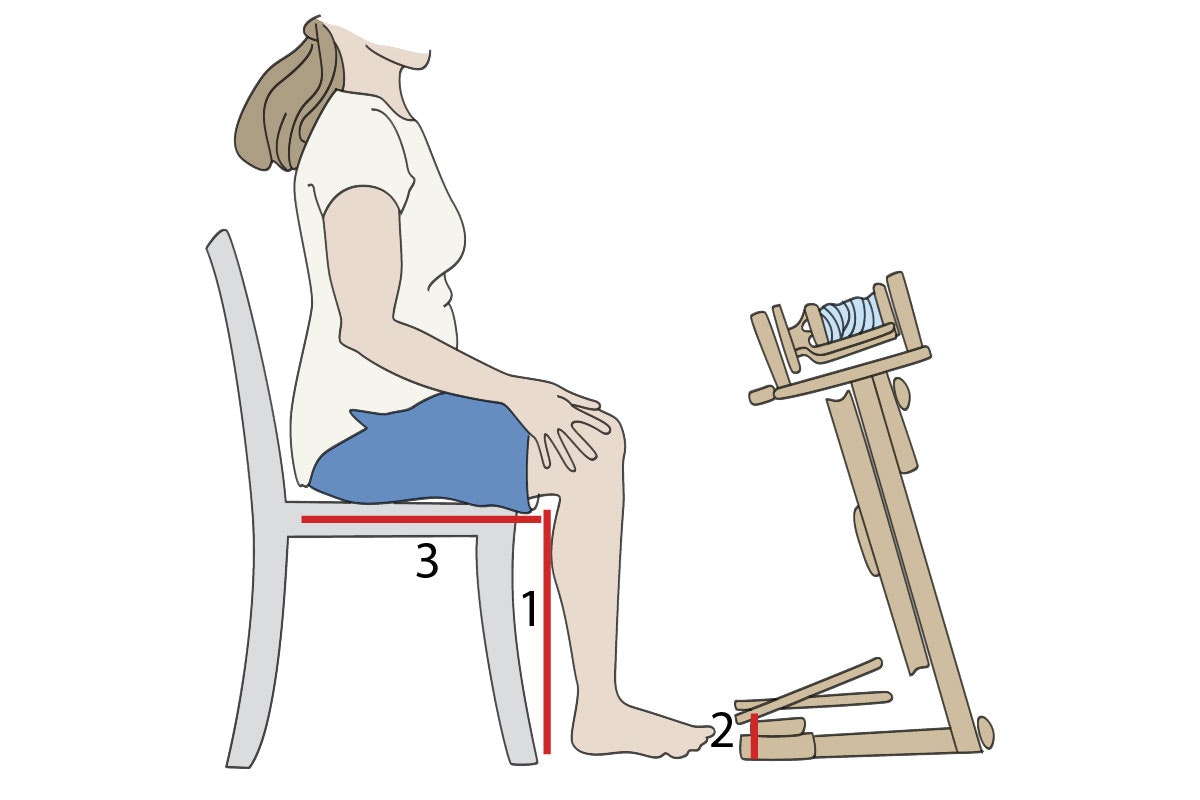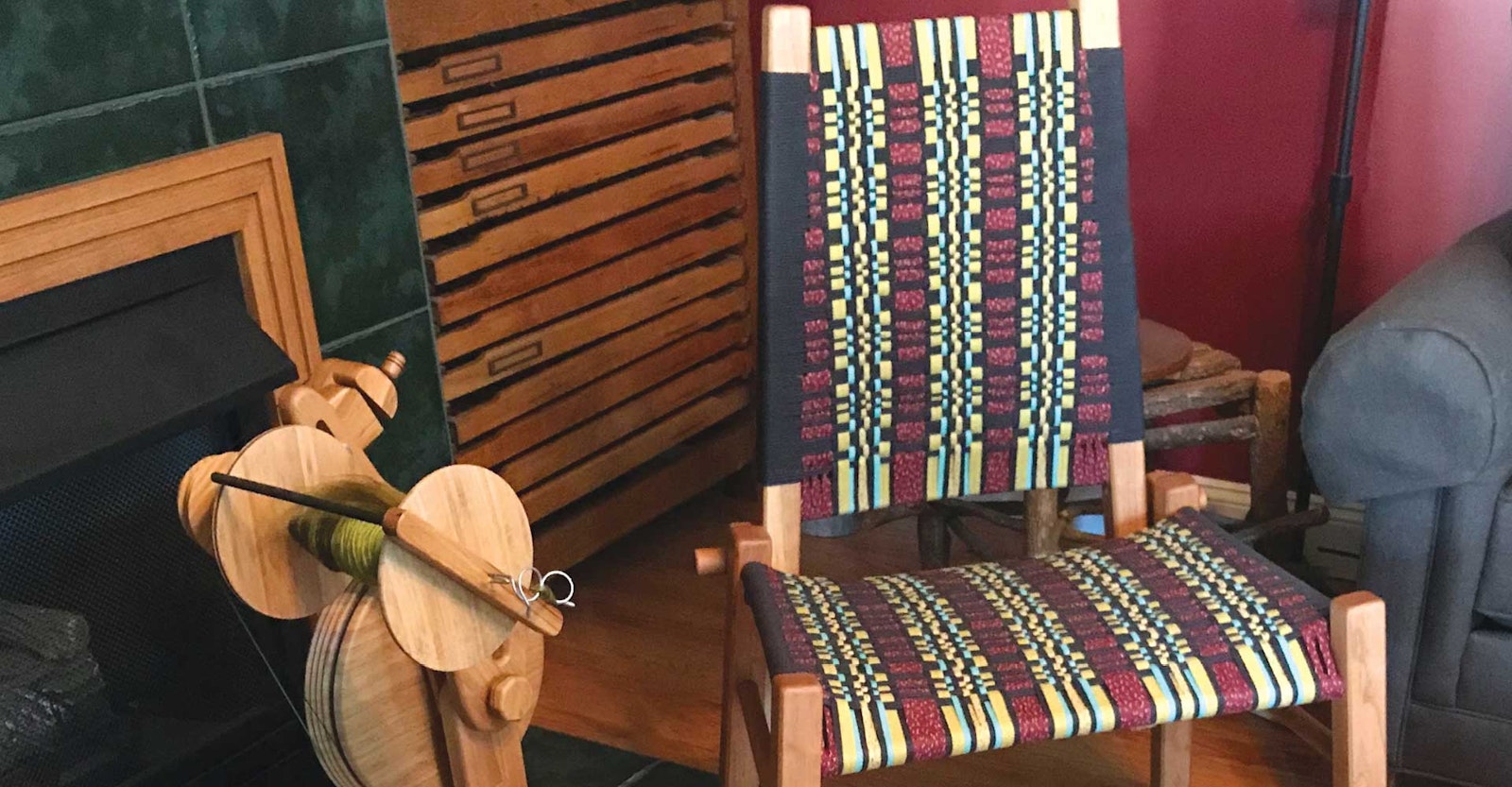You have found the perfect spinning wheel, but what about your chair? Sitting in a chair that does not allow for correct spinal and joint alignment can cause pain and overuse injuries over time. A poorly fitting chair that results in ill posture can also cause preexisting issues such as sciatica, back pain caused by herniated discs, shin splints, leg pain, or other ankle and foot issues to flare up. Most spinners don’t give their chairs a second thought, but if you have developed new pains while spinning or your old aches and pains are getting worse, don’t blame your wheel first; it could be your chair or posture. Let’s look at the chair you sit in most to spin. You may find that a few minor adjustments will help you spin with comfort.
Why Your Spinning Chair Matters
The nervous system is a complex structure in the body that starts at the brain and travels down the spinal cord into peripheral nerves, which end up in muscles, skin, or organs. Nerves are labeled motor, sensory, autonomic, or cranial. Nerves work best when signals to and from the brain are unobstructed and able to flow freely. When a nerve is compressed, pinched, or cut due to trauma, it causes a disruption in the signal that can lead to tingling, weakness, pain, and in some extreme cases, paralysis. We will discuss the motor nerves here, because they are most affected due to poor sitting postures.
Motor nerves connect the brain to individual muscles via the neuromuscular junction, which create muscle contractions throughout the body. Damage to these nerves can result in tingling, numbness, muscle weakness, or even muscle wasting. The area of weakness depends on which nerve is damaged and which muscle that nerve innervates (or supplies). The spinning chair you are using could be the cause of the some of these issues.
Seat Depth
If the crooks of your knees hit the edge of the chair seat, you may be setting yourself up for a nerve compression injury. When there is pressure against a nerve, such as when the back of your knee presses on the edge of a chair, this pinches the nerve, which can cause disruption of the signal from the brain to your lower leg. The tibial and popliteal nerves run down the back of the knee, and pressure from the edge of the chair can compress them and cause pain, tingling, numbness, or weakness of your legs. If compression on the nerve persists, you could end up with permanent nerve damage. You can also experience compression of the popliteal artery that runs alongside the nerves. Symptoms of arterial compression may be numbness, pain, or cold feet.
To correct your seat depth, place a pillow behind your back, scooting closer to the edge of the chair and allowing two to five inches of space from the crook of your knee to the edge of the chair. This gives your nerves and arteries the freedom they need to work at their best.
Armrests or No Armrests
If you love to spin with a long draw, use a chair with no armrests to give yourself room to move. If you attempt to spin with a long draw while seated in a chair that has armrests, your elbows could hit them as you draft, or you could be forced to move awkwardly. If the body moves this way over and over again, the stresses and strains on the soft tissue and joints will ultimately cause pain. Keep your long-draw length shorter to prevent overtwisting your spine.
If you mostly spin with a short draw, armrests are okay. However, do not lean your elbows on the armrests when you spin. This can cause compression of the ulnar nerve that runs along the back of your elbow, also called your “funny bone.” Some symptoms of ulnar nerve compression are tingling or numbness in the ring and little fingers or the palm of the hand, or pain in the forearm or elbow. If you don’t have armrests and your shoulders get tired or you experience neck pain or fatigue, place a pillow on your lap and rest your forearms on the pillow when you draft. This will let your shoulders and neck relax as you spin.
Seat Height
This may be different for each body. If the seat height is too low, it can cause pain in the hips, shins, or ankles over long periods of spinning due to the amount of muscle force it takes to treadle. Raising the seat height allows for smoother treadling and less muscle force. Give it a try; you will be surprised at the difference in treadling effort.
Custom chair and bench maker Walt Turpening has an easy formula for determining the optimum height of your spinning chair. If you determine that you need to raise the height of your chair and it isn’t adjustable, you can put risers under the chair legs, or you can slip a piece of upholstery foam into a pillowcase or handmade cover and sit on it to raise you to the required height.

Spinning Posture
Once you’ve found the perfect spinning chair, it’s important to think about how you are sitting in it. Even the best spinning chair can lead to pain and fatigue with poor posture.
How Close Should I Sit to the Wheel?
When sitting down to the wheel, one thing to think about is your foot position on the treadles. This will determine the distance between your chair and wheel. Make sure you place your whole foot on the treadle pad so you are using the whole foot to treadle and not just your toes. It should be a heel-to-toe sort of movement as you treadle and use the power of the entire foot to fight leg and foot fatigue. You may need to move your wheel a bit farther from you to get your feet in the proper position.
How Close Should My Hands Be to the Orifice?
Let’s think about the mechanics for a second. If you were to spin with your hands close to the orifice (say, two to three inches away), you would essentially have to hold your arms up in the air. This position would require a great deal of shoulder strength and stability to perform the task, especially if you spun for 30 minutes straight. Try to hold your arms out in front of you for 30 minutes. I don’t know about you, but my shoulders would protest quickly. The ideal position is to relax your arms at your side with about a 90-degree angle at the elbows. For most of us, this will mean that while spinning with a short draw, our hands are somewhere over our laps. Some spinners even rest their hands in their lap or on a pillow in their lap when they spin. Give this a try; your shoulders will thank you.
Spinning Position
Poor sitting posture can cause a myriad of problems, from back, shoulder, neck, or leg pain to headaches or even fatigue and restlessness. Poor posture puts pressure on joints, ligaments, and spinal discs that can cause injury over time.

Illustrations by Ann Sabin Swanson
The most popular, but worst, sitting position is a slumped position that places weight on the tailbone (A). Note that the pelvis is rotated backward. In this position, there is a great deal of stress on the vertebrae that over time can cause pain and possibly disc herniations. If you already have a disc herniation, you should avoid this position altogether. A slumped posture also causes a forward head position, compressing the bones at the back of your neck. This can cause the impingement of nerves, which can ultimately produce pain or even tingling or numbness in the arms or hands.
Conversely, if the lower back is hyperextended, causing the pelvis to tilt too far forward, it may create muscle fatigue and issues in the upper and lower back fatigue (B). If you have issues such as spinal stenosis or foraminal stenosis, this is definitely not a position you should maintain for long periods of time.
The optimal sitting position has the pelvis in what’s called a neutral position (C)—not too far forward (lower back hyperextended) and not too far back (slumped position). To maintain this position, place a small pillow or lumbar support pillow at the small of your back to support your pelvis. It might be even more comfortable if you place a bed pillow lengthwise behind your upper back for further support. This sitting position is optimal for tissue and joint health and will allow you to spin more comfortably. Once you have adjusted your chair and posture, you will enjoy spinning even more. Don’t forget to get up every half hour to move and stretch, so you can continue to spin with comfort for years to come.

Mary uses a comfy chair that she modifies with a pillow. "This is my favorite chair to spin in, because it is the perfect height for me and the type of wheel that I use, not to mention it’s red and super comfy. I always use a pillow behind my lower back; the extra support keeps me in good form. I love spinning chairs without arms because they let me draft with a long draw with ease." Photo courtesy of Mary Egbert
Mary Egbert’s fiber journey started in 2005 with a herd of 25 alpacas. A physical therapist since 1995 and a natural-born researcher, Mary’s quest to spin a balanced yarn resulted in the development of the Eszee Twist Tool and Yarn Planner. Mary is the owner of Camaj Fiber Arts and The Spinning Box, and her YouTube channel, Camaj Fiber Arts, has over 100 videos sharing her techniques for prepping, dyeing, and spinning fiber. She lives in sunny Florida with her family and can often be found walking on the beach as the sun comes up.

